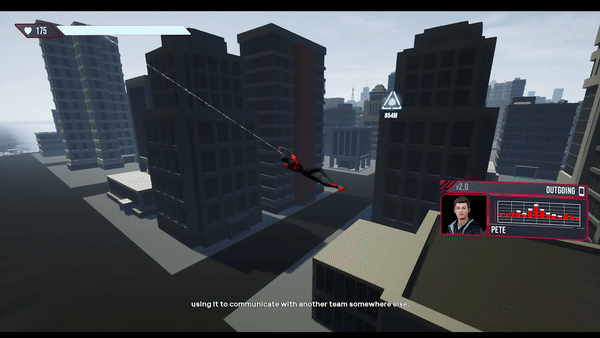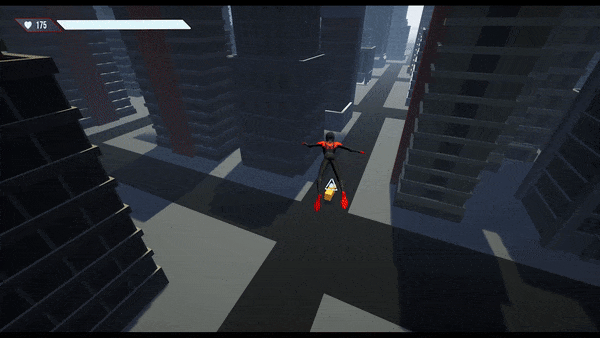
Spider-Man: 'Operation Radio Silence'
With the recent release of Spider-Man 2, I aimed to analyze and practice close-combat encounter designs, drawing inspiration from previous games in the franchise. In this project, I've integrated narrative, scripting, and interactive elements to provide an immersive player experience.
To see the full gameplay video, click here!
Click the images to get a better view!
Goal:
-
Craft a fun and quick-level design where I can analyze and practice close-combat encounter designs, integrating narrative, scripting, and interactive elements to provide an immersive player experience.
Project Details:
-
ENGINE: Unreal Engine 5
-
LANGUAGE: Blueprints
-
DURATION: 3 Weeks
-
TEAM SIZE: Solo project
Learnings:
-
Create multiple combat encounters to analyze the design choices made by the original developers
-
Analyze combat metrics, design choices, and what makes combat 'fun'
-
Design a fun and dynamic environment where players can have agency during the level
-
Integrate a narrative-rich mission with interactive elements and cutscenes into the main game’s storyline for a more immersive player experience
-
Design scripted events that can be integrated into the narrative, providing a continuous challenge for the player
Assets Used:
-
Spider-Man Character Controller by Lewis Fiford (Programming)
-
IWALS by Jakub (Programming)
-
POLYGON - Prototype Pack (Art)
-
Good Sky (Art)
-
Construction Site VOL. 1 (Art)
-
Construction Site VOL. 2 (Art)
-
Industry Props Pack 6 (Art)
Research and Design Ideas
This moodboard showcases all the reference images I used to design the environment, along with along with the Level Design document and a brief design reference of some of the concepts I added to the level.

Paper Designs
These are the paper designs I initially sketched to determine the environment, its size, and functionality. It served as an initial idea to start building the blockout

First sketch design of the construction building combat encounter. Several elements were later modified in the final blockout section.
I aimed to incorporate verticality into this scenario, introducing sniper enemies on higher platforms. This allows the player to analyze and strategize before engaging with the enemies.

For the dock encounter, I aimed to create a more constrained scenario with more enemies. This approach would make it more satisfying for players to take out enemies stealthily.
I wanted this encounter to be focused on stealth and narrative, incorporating cinematics and scripted events.

Construction building layout but made in Photoshop for better readability. Several elements were later modified in the final blockout section.
Layout and Development
From the start of the project, I wanted to design multiple combat encounters where Miles Morales could use some of his traversal mechanics while having agency at all times. I wanted to play with the level metrics, ensuring they are as close as possible to what the original designers achieved for the original games.
The narrative of the level unfolds as follows:
-
Narrative: Fisk’s men have established a communication hub on a construction building. They are using this to communicate with another team engaged in contraband activities at a dock. The dialogue happens between Miles and Peter through calls, related to the group and their plan behind the construction building and the dock area.
-
Objective: Eliminate Fisk’s men and deactivate their comm antennas on top of a construction building, find the dock location, and end their operation once and for all.
The level begins with a dialogue between Miles and Peter, introducing the mission objective and the main enemy faction. Instead of starting the level directly at the first combat encounter, I designed it to involve an initial traversal to the construction building. The reason for this was that I wanted to immerse players in the character's dialogue and the narrative of the mission first, before combat or any character interaction with the enemies.
I scripted an objective system with a UI in world space. This system constantly has access to the player's location, allowing me to trigger events and multiple dialogues throughout the mission.

After a brief intro cinematic at the construction building, players must fight and clear the building to deactivate the antennas. Since there's no combat in this level design, I enhanced the presentation by incorporating cutscenes, cinematics, and dialogue while showcasing the blockout and the combat encounter.




Multiple views of the Construction Building encounter

Some floors have construction grills for better player visibility below

The snipers are strategically positioned in high places to introduce verticality to the encounter, adding a sense of challenge and strategy for players as they takedown the enemies. Additionally, players can utilize beams and columns for perch takedowns and traversal throughout the encounter.
For the final combat encounter, I wanted to create a more open space while focusing on stealth, which is the opposite of the previous encounter. Once players reach the warehouse at the dock and receive the new objective, there's a brief cinematic, offering a view of the enemies there and providing additional narrative through dialogue.
The only entrance to the warehouse is through a roof window, visible during the brief cinematic. The main reason for this choice was to distinctively separate the dock space from the warehouse, giving each location its own unique identity. To direct players to this window entrance, I'm using leading lines and lighting, which are handy concepts frequently used in level design.






Multiple views of the Dock and Warehouse encounter
After clearing the warehouse, players must engage in a short chase sequence with a truck, providing traversal, a moment of adrenaline rush, and a conclusion to the mission. Early in the warehouse design phase, I knew I wanted a scripted sequence to integrate the mission's narrative with player mechanics while also practicing using Blueprints. To achieve this, I implemented multiple transforms across the map that the truck follows as a path, all while using the objective system I scripted earlier, attached to it.
Multiple dialogues play in this chase sequence based on the distance between players and the truck. This encounter was a lot of fun, and I really enjoyed working with the scripting sequence and the dialogue.

Iterations
One of the aspects I iterated on for the level design was the warehouse at the dock. Initially, I had it set up for the player to fight all the enemies at the same time with all the doors at the warehouse open. However, I later decided to shift the focus more to stealth, providing only one entrance for players. The goal was to separate the outside and inside areas, making each space more unique. This design choice also encourages player exploration, using leading lines and lighting to guide them toward the goal/entrance.
During the design of this project, I iterated on the character model and its animations. I knew from the beginning that I wanted to make the narrative and objectives around Miles Morales, but the character controller provided by Lewis Fiford was only available for Peter Parker. For me, it was very important to make Miles Morales the main protagonist of the mission, while incorporating dialogue between Miles and Peter for narrative purposes.
To achieve this, I ended up re-targeting all of the animations from Peter Parker. Additionally, I tweaked the character controller blueprint to seamlessly integrate Miles Morales. Through this process, I learned about the pipeline behind retargeting animations and how to integrate it seamlessly into a project.
Conclusion
After working on a blockout environment for one of my favorite franchises, I can confidently say that the developers performed an incredible job, and crafting encounters for a game this big is no easy feat. Drawing inspiration from the multiple locations and missions from the Spider-Man franchise, I delved into the analysis and practice of some of the design concepts used in the original game's combat scenarios. Throughout the process, I tried to stay as close as possible to the metrics used by the original designers while following closely with their thought process to ensure an authentic experience. Additionally, I would have also loved to include combat and some of the takedown mechanics, like in the original games. However, due to time constraints and the complexity of those systems, I decided to simplify the design and focus solely on level design and narrative.
I'm really happy with the final result, particularly with the seamless integration of narrative elements and scripting into the blockout, enhancing the overall player experience. This project not only refined my design skills but also deepened my appreciation for the intricate design process behind creating levels and a narrative for a game like Spider-Man.

Level design layout with the enemy patrolling path for the construction building

Level design layout with the enemy patrolling path for the dock and the warehouse











